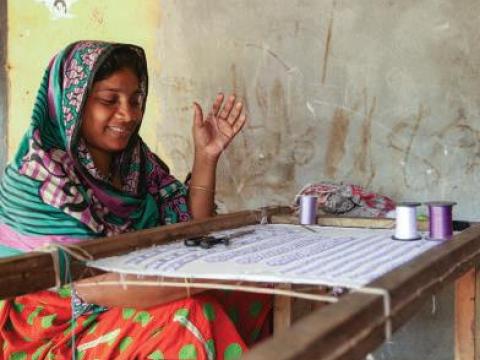Promoting “Balance for Better” through Women’s Economic Empowerment

By Chloe Bass, Technical Advisor for Women’s Economic Empowerment, World Vision US
The theme for International Women’s Day this year is “balance for better” and it could not come at a better time. In 2016, the High-Level Panel on Women’s Economic Empowerment was established by the United Nations Secretary-General. Earlier this month, the US Government launched the Women’s Global Development and Prosperity Initiative, its first-ever whole-of-government approach to promoting women’s economic empowerment. These are just a few examples! All around the world, people, communities, organisations, businesses, and governments are recognising the benefit of women’s empowerment as a goal in itself and a means for achieving many of the other development outcomes we hope to see.
McKinsey Global Institute found that $12 trillion dollars could be added to global domestic product (GDP) by advancing gender equality, raising global GDP to almost $25 trillion USD.[1] The Food and Agriculture Organization (FAO) of the United Nations has stated that if women had the same access to productive resources as men, they could increase yields on their farms by 20 to 30 percent. They also found that ensuring that women have the same access to agricultural resources as their male counterparts could lift 100 to 150 million people out of hunger.[2]
We also know that when mothers are economically empowered, their whole families are likely to benefit. We see improvements in food consumption, nutritional status, education levels of their children, and much more. As an organisation working for a better world for children, promoting the economic empowerment of women who are mothers is crucial for building a better world for children.
Our women’s economic empowerment work focuses on the following two areas: building the ability, access, and agency of women, while also supporting an enabling environment where women can thrive. This can happen by addressing barriers to women’s participation and promoting opportunities for women’s involvement and leadership. Generally, women can achieve economic empowerment with the following five things: economic advancement; access to opportunities and life chances; access to assets, services and support; decision-making authority; and manageable workloads.
In Zimbabwe[3], we facilitated the training of female farmers and formation of marketing groups. That led to linkages to private sector buyers, improved financing, and increased revenue by 23 to 200 percent for the women. Simultaneously, we addressed women’s workloads and the heavy time burden they had by promoting male engagement in caregiving for children and in doing household tasks. Globally, women do two to 10 times more unpaid care work than men do, oftentimes in addition to their paid work.[4] This was the case in Zimbabwe, but after our programming, we saw a male engagement increase of 64 to 72 percent in household tasks and caregiving for children.
Another example of our promotion of #BalanceforBetter, is our Nobo Jatra programme, funded by USAID’s Office of Food for Peace in Bangladesh. In that programme, nearly 2,000 women have received leadership training and many of them are holding leadership positions within their communities. In addition, over 8,600 women have been trained on Alternative Income Generating Activity (AIGA) trade, and are now earning steady incomes through their chosen trade. These include hand embroidery, turkey rearing, tailoring, basketry, dry fish processing, and other trades. For example, for each piece of hand embroidery completed, woman earn an average of $75 USD – a sizeable amount in Southwest Bangladesh where 34 percent of the population live below the lower poverty line of $1.90 USD per day. At the same time, we are promoting male engagement in care giving here as well, which positively affects women’s time burden and workload.
These are just a few examples of some of the great work we are doing to support women’s economic empowerment and #BalanceforBetter.
Where have you seen good examples of women’s economic empowerment? Where do you see opportunities to strengthen the empowerment of women in your programming? Join our real-time updates and chats on Slack to let us know!
You can also subscribe to World Vision’s Livelihoods Community of Practice newsletters to stay up to date with our impactful livelihoods work!
Chloe Bass is the Technical Advisor for Women’s Economic Empowerment at World Vision US, based in Washington DC. She has 15 years of experience working with non-profit organisations and INGOs in the United States, Africa, the Middle East, and Southeast Asia. She is also a Certified Professional Coach and the founder of Making Working Motherhood Work, a coaching and consulting organisation dedicated to helping new moms and moms with young children to successfully navigate the transition to working motherhood. She is a Licensed Minister, and also has her MA in International Administration, Human Rights, and Humanitarian Assistance, and her BA. in Biblical Studies and Communication.
[1]McKinsey Global Institute, 2015. The Power of Parity: How Advancing Women’s Equality Could Add $12 Trillion to Global Growth.
[2] Food and Agriculture Organisation of the United Nations. The State of Food and Agriculture 2010 – 2011. Women in Agriculture Closing the gender gap for development. FAO.
[3] This was part of World Vision’s ENSURE programme, funded by the United States Agency for International Development USAID’s Office of Food for Peace.
[4] https://www.oecd.org/dev/development-gender/Unpaid_care_work.pdf. Unpaid Care Work: The missing link in the analysis of gender gaps in labour outcomes. OECD Development Centre, December 2014